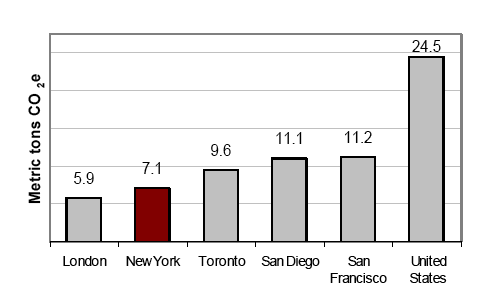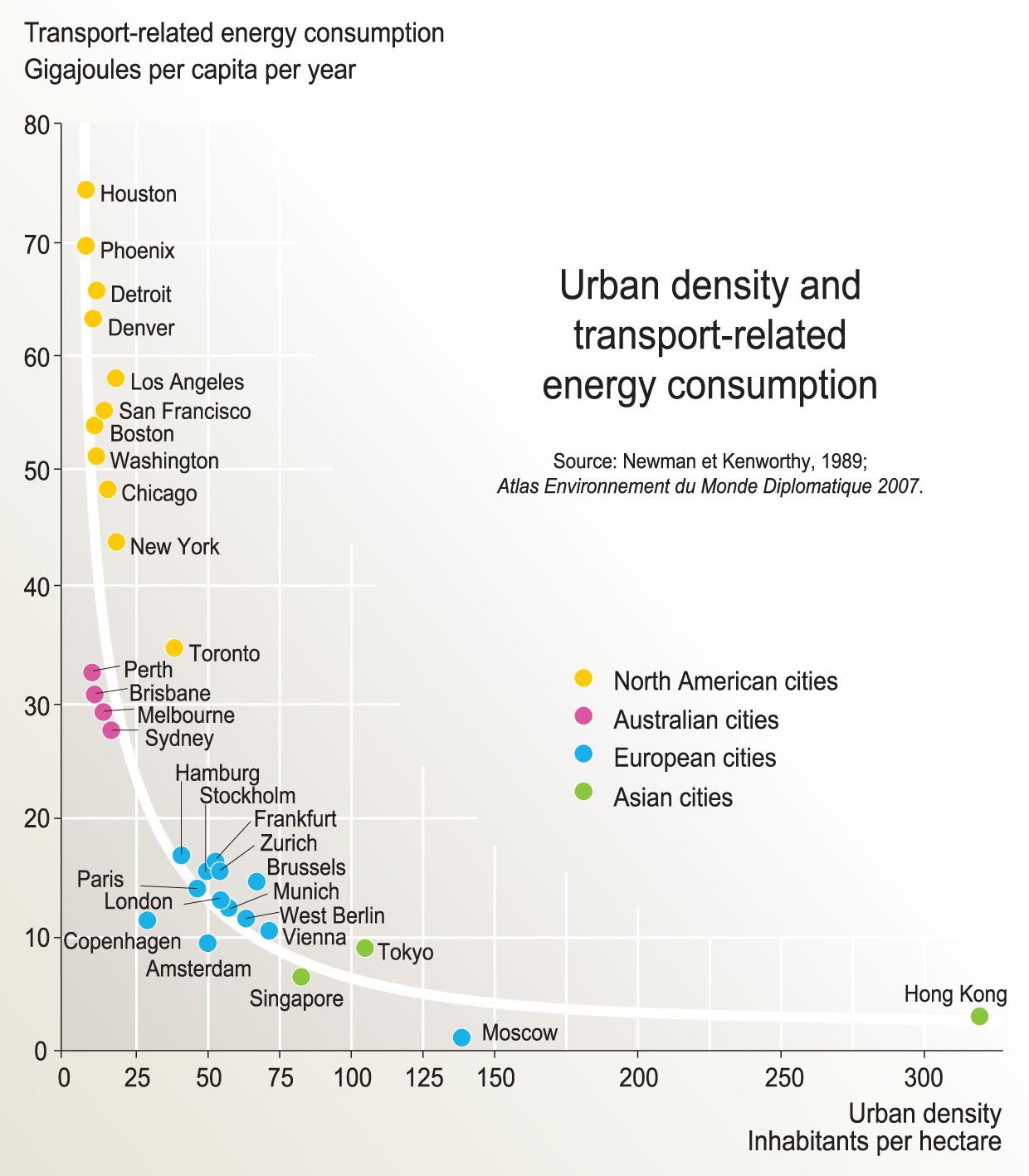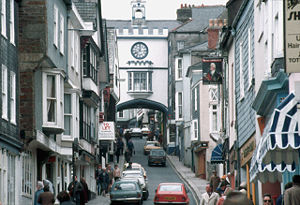Let’s Kick Around Those “Sustainability” Types
April 19, 2009
“Sustainable” this and that seems to be on the upswing these days, and with Peak Oil and various forms of environmental degradation at hand, it makes sense.
I’m all for the “sustainable” paradigm in the broad sense, but I have to say the current crop of “sustainability” advocates, especially the U.S. variety, sure seems like a pathetic bunch of losers. After — what is it now? — about forty five years of this stuff, you’d think they would have been able to develop something interesting. Instead, it seems that everything they say falls into two categories:
1) We need to live on little teeny family-owned farms, and grow pigs and tomatoes and stuff; or
2) Use less toilet paper.
OK, I’m joking, but I’m not joking very much. Number 1) I see as mostly a sort of Little House on the Prairie creation myth, an attempt to return to a 19th century pioneer lifestyle which forms a large part of the national self-image, even if it is sort of a fantasy. Take Benjamin Franklin (1706-1790), for example: a wealthy businessman, inventor, and diplomat. Probably didn’t have a canned-tomato fetish. Didn’t milk goats. Lived in a dense urban area. Can’t we be more like Ben and less like Pa Ingalls?

“Fuck zucchini.”
Sharon Astyk (www.sharonastyk.com) definitely falls in the little-farm-fetish camp, as she owns a little farm in upstate New York, and does all sorts of hokey pioneer-housewife stuff although she has a graduate degree. (Needless to say, she doesn’t make dogshit for money, and I wonder what Poor Richard would have to say about that?) But even Sharon says her fantasy view of the “sustainable” future has perhaps 10%-30% of the population actively engaged in food production, which of course leaves 70%-90% to live a more Ben Franklin-like urban lifestyle. There doesn’t seem to be any place in the “sustainable” camp’s Little House on the Prairie fantasies for these 70%-90% of people who are not farmers. They are just not part of The Vision.
If 10% of the population is involved in food production, then of course each person must produce about 10 people’s worth of food, or maybe 40 people’s worth for a farming family of four. This is not a big farm, but it is not three acres either.
Now, I have some experience with this, because one of my neighbors is a pioneer-housewife/extreme gardener, and she can plant and sew circles around Sharon Astyk — because she comes from a family that has been doing this continuously for generations. I think it’s great. And, I buy vegetables from her all summer, because it’s soooo much better than the crap in the supermarkets. In short, I’m living the Michael Pollan sustainable local food fantasy. I’m glad that my neighbor is doing all that stuff, so I don’t have to.
And she’s glad that I’m not doing it either, so I can come and buy stuff from her. Get it?
By the way, the ideal of little family-owned farms is not necessarily that hard to achieve. In Japan for example, all the farms are small and family owned. The government simply made it illegal for a corporation to engage in agriculture, because, like Europeans also, they wanted to preserve the tradition of small family-owned farms. Simple as that. And it worked! Food prices are somewhat higher, but you would expect that given Japan’s topography and climate alone, and the quality is much higher as well. On balance, it is a good policy if you ask me. Sometimes these things are really easy to solve.
This brings us to 2). I’m using toilet paper as a stand-in for all the weird little privations that the “sustainability” types fixate on, which seem to have value to them if a) they cause as much inconvenience and hassle as possible, and b) are totally irrelevant regarding resource use, the environment, monetary expense etc. Which is the exact opposite of the kinds of solutions you should be looking for. Hey, use as much asswipe as you need. Don’t skimp. Trust me on this. If it really bothers you to use dead trees to clean your bum, then install one of the very cushy bidet systems offered by Japanese makers like Toto, which you can add to your existing toilet. Squirty squirty. Problem solved again.
Another currently-fashionable eco-geek fetish is the solar oven. Like Sun Tea in the 1970s (remember Sun Tea?), this is a nice trick, but doesn’t really accomplish anything. How much energy is your regular oven using, during the three or four hours a week (tops) that you use it? Probably just a little above jack squat. Use your regular oven and don’t worry about it. It is meaningless compared to the energy your water heater is using. Like I said, the solar oven a) causes as much inconvenience and hassle as possible, and b) is totally irrelevant regarding resource use, the environment, or monetary expense. So you see, although it may seem like a solar oven doesn’t have much relationship to skimping on toilet paper, actually they are products of the same repetitive thought process.
There are the techno-fetishists as well, who gather at conferences to have a community wank-off about smart grids and solar panels in the desert, and electric cars. Most of this stuff is sort of the eco-gadget equivalent of ethanol — the value expended is about equal to the value gained, leaving little net value production. Which is a way of saying: the result from building it is roughly equivalent to the result from not building it. Ethanol (or other biofuels) are a wonderful wank-off, but they don’t actually accomplish anything, except (ironically) greater environmental degredation. (“Yes, but we know that!” say the sustainability types. To which I say: “And your eco-gadgets are just the same, but you haven’t figured it out yet.”)
That’s about it for forty-five years of effort, as far as I see it.
So, let’s look at this from a little different angle. I’m not going to talk about farming and I’m not going to make any more bathroom jokes.
What are the other 70%-90% of the population who aren’t directly involved in food production going to do? They should be living in traditional urban areas, whether very small ones (villages, possibly in agricultural regions), or larger ones. Like Ben Franklin, and every other non-farmer for the past 5000 years or so.
I’ve written a whole series on this, precisely so I can plug it into the discussion at advantageous times such as these:
March 3, 2009: Let’s Visit Some More Villages (scroll down for links to more commentary)
I had to describe what a traditional Really Narrow Street-ed no-car urban area is, before I could talk about it further. Because, such places in the U.S. are extremely rare.
Urban living is much less resource-intensive than suburban (i.e., ersatz-rural) living:

source: the Oil Drum
The average New York City resident uses only 29% as much energy (here described as tons of CO2 emissions) as the average (suburban) American. Isn’t that amazing? Because New York City residents aren’t even thinking about using less energy, it is inherent in their lifestyle. Londoners use a little less. How much less could they use if they were actively thinking about it? For example, if energy prices were 100% or 200% higher, in which case everyone would be thinking about it? Another 50% decline would be very simple. New Yorkers would start spending their weekends at Coney Island again, instead of Cancun. Or, their buildings could be better insulated.
There would be zero hardship involved. If the fashionable people started spending their weekends at Coney Island instead of Cancun, then Coney Island would be a party festival just like Cancun, and you could take the subway there instead of an airplane, and get there in 60 minutes instead of five hours. (Admittedly, Cancun is warmer in February.)
As you might imagine, New York or London is not really the ultimate example of low-energy urban living. No, that award is held by … Moscow!

This shows that you can have a regular modern lifestyle and use very little energy, if you set things up that way. Singapore, Tokyo and Hong Kong, are very happening places, where nobody is trying to drive under 40mph to save gas or other such “just one sheet of toilet paper” stupidities. Their energy efficiency is again inherent in their design, which is to say, the design of a Traditional City (with subways) rather than a suburban mess like Houston or Phoenix. If we guess that Singaporeans are using 7 GJ/capita/year and Phoenix 70, then we see an amazing ten to one improvement! And, if people in Singapore or Tokyo actually tried to use less energy, for example by cutting back on recreational weekend driving and overseas plane trips, their energy usage would probably be more like that of Muscovites. (Apparently this is already happening, as young people in Tokyo decide that it is more fashionable to not own a car.)
The energy/resources not-used by living Amsterdam-style instead of Houston-style is much, much greater — about a million times greater — than the energy/resources not-used by using a solar oven instead of a regular oven, or cutting back on TP. Do you see why I’m making fun of the solar-oven fetishists?
We can also see that there is at least a loose correlation between urban density and energy use. Now, can you see the problem with telling everyone to live on a little farm? That is the opposite of urban density — although it is an almost perfect description of the ersatz-farmhouse of the suburbs, resulting in Houston/Phoenix like energy use.
The other funny thing here, is that there is a roughly inverse correlation between energy use and having a good time. I can say with some authority that Singaporeans, Hong Kongers, Muscovites and Tokyoites have waaaay more fun than people living in Detroit, Los Angeles and Chicago. This is because denser, traditional-style cities are much more fun than the suburban wasteland. So, we are not giving anything up. Quite the opposite.
Unfortunately, rather a lot of self-proclaimed “sustanability” advocates are prone to claiming that all sorts of cities are “unsustainable,” pretty much just because they are cities. What they really mean is that cities aren’t small family-owned farms, which means that they don’t fall in The Vision, and the people living there are not part of the “sustainability” club with their reusable dishware hanging from carabiners on their backpacks. Actually, cities have been an inherent part of human civilization from pretty much Day 1, the Sumerian age beginning 3500 BC. Jerusalem, Baghdad and Beijing have managed to sustain themselves for several millenia now. Jim Kunstler — a self-proclaimed “urbanist” and isn’t that a joke — insists that tall buildings are completely “unsustainable” and have no place in a more eco-aware future. Considering that Hong Kong has the lowest transportation energy use in the above graph of any city except Moscow, I wonder exactly what he means by that. The electric subway is bettered perhaps only by the elevator in the heirarchy of superefficient, superconvenient transportation options. We could compare to the average resource usage of residents in his own Saratoga Springs on the above graph, and I bet it wouldn’t be too favorable.
The above graph measures only transportation energy usage, but other energy and resource usage tends to correlate as well. For example, places with high population density tend to have smaller living spaces, which use less energy to heat and cool (a LOT less, like 70%+ less), and of course take less materials to build in the first place, and are much less of a temptation to accumulate endless amounts of consumer junk (no garages, basements, attics, home theater rooms, backyards, guest bedrooms, enclosed porches, breakfast nooks, etc. etc.). I think Kunstler is really against the Hypertrophic City pattern that has spread like cancer around the world over the past eighty years. I also prefer the under-ten-story height of the Traditional City, but if you throw in a few taller buildings here and there it is OK with me.
The reality is, a dozen designer-clothes-wearing super hot Russian girls dancing the night away at a Moscow nightclub, and sipping overpriced cocktails, are probably using less energy and resources than it takes to carry a load of cow manure fifteen miles in a twenty-year-old Ford F-150 pickup. Which is more “sustainable”? Which is more fun? What do you want to spend your time doing?
If I’ve been doing my job right, by now the “sustainability” fetishists should have blood squirting from their eyeballs. Noooo! It can’t be truuuuue! Well, you’ll get over it. Then, we can get beyond our fascination with turnips and think about what sort of civilization we should have.
Europeans and Japanese already understand most of this stuff, because they (mostly) already live in this sort of arrangement, and if they don’t, at least there are examples of it nearby. The idea of “Transition Towns” has gained some traction. Note that they aren’t called “Transition Farms.” For those that have been following my discussion of Really Narrow Streets and Traditional Cities, this photo of one of the first “Transition Towns,” Totnes, England, should echo familiar themes:

The New York Times had a lengthy piece on “Transition Towns” this week. I am a little surprised at the amount of attention this particular movement has been getting.
NY Times on “Transition Towns”

